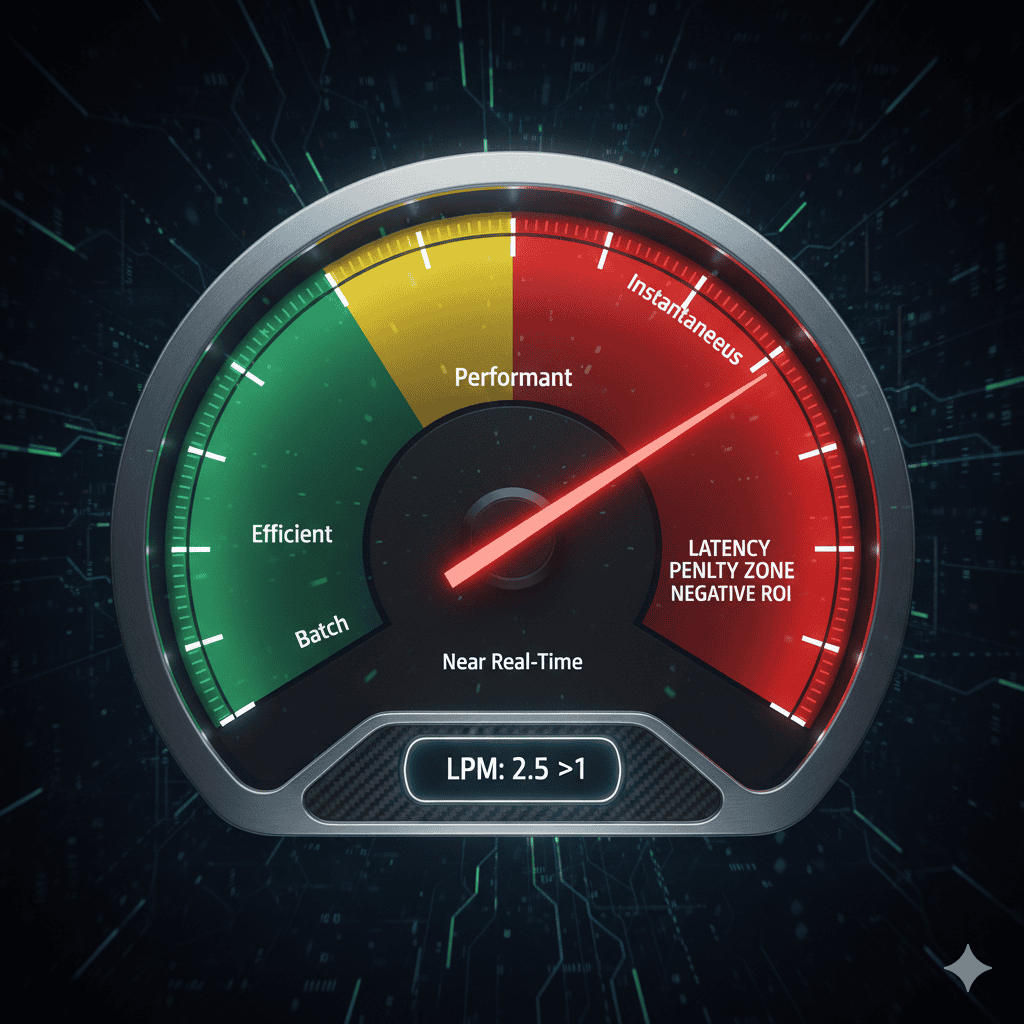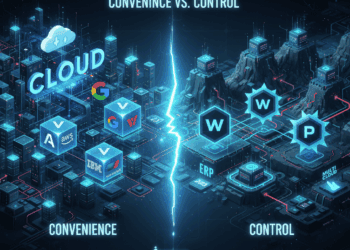The Operational Cost of AI: When Speed Becomes a Liability
TL;DR
In our previous article, we unpacked the hidden friction of GPU adoption—high CapEx, cooling, licensing, and operational complexity.
This follow-up explores why enterprises fall into that trap: the obsession with instantaneous speed.
The pursuit of “real-time AI” drives organizations to overprovision infrastructure, chase unnecessary GPU capacity, and inflate OpEx for workloads that don’t benefit from it.
Speed becomes a liability when the incremental cost of achieving lower latency exceeds the incremental business value it delivers.
This piece introduces the Latency Penalty Multiplier (LPM)—a simple framework for knowing when that tipping point has been reached.
Why Speed Became the Liability
In enterprise IT, the reflex to “go faster” is almost cultural. When a business unit asks for AI, the first question is usually, “Can we make it real time?”
That question drives costly architectural decisions:
-
Large models instead of right-sized ones.
-
Dedicated GPUs instead of shared compute pools.
-
Always-on inference clusters for workloads that run once an hour.
In our earlier analysis, we explored the operational friction of GPUs—cooling, power density, vSphere integration, and specialized talent.
In this continuation, we address what causes that friction:
the enterprise demand for instantaneous speed, whether or not the business outcome requires it.
The Real Cost of Chasing Speed
GPUs are built for throughput, not efficiency.
When organizations pursue “real-time AI” indiscriminately, they enter what I call the Latency Penalty Zone—the range where each incremental performance gain costs disproportionately more.
The Latency Penalty Multiplier (LPM)
A simple way to model this is:
LPM = (Incremental Cost of Speed Gain) ÷ (Incremental Business Value of Speed Gain)
When LPM > 1, speed has become a liability.
For example:
If moving a batch fraud detection model from a 2.3-hour CPU job to a 14-minute GPU job costs 60% more to operate, but the faster output doesn’t reduce fraud losses or generate new revenue, the LPM exceeds 1.
That’s the signal: you’re paying for performance that the business can’t monetize.
Why “Faster” Rarely Equals “Better”
| Business Pressure | Engineering Reaction | Result |
|---|---|---|
| “We need real-time insight.” | Deploy GPUs and re-engineer pipelines for low latency. | Massive infrastructure cost with no SLA-linked value. |
| “We can’t afford lag.” | Scale model size for marginal accuracy gain. | Higher training and inference cost, lower utilization. |
| “We should match hyperscaler performance.” | Replicate consumer-grade latency standards. | Unnecessary acceleration for internal workloads. |
Speed becomes a liability when it drives architectural vanity—chasing hyperscaler benchmarks instead of business outcomes.
Executive Off-Ramps: Questions and Alternatives
CTOs can’t simply say “slow down.” They need structured ways to redirect conversations.
Here are three levers that shift the focus from raw speed to right-sized value.
1. Reframe the Latency Trade-Off
Ask:
“Is the difference between one second and five seconds of response time worth a 50% increase in budget?”
In customer-facing AI, milliseconds matter. But for internal analytics, even minutes often don’t.
Quantify the trade-off in dollars per millisecond before committing to scale.
2. Right-Size the Model
Not every problem needs a billion-parameter LLM.
Use model distillation or quantization to shrink large models into cheaper, faster, domain-specific variants.
Reserve large models for workloads where marginal accuracy delivers measurable revenue or risk reduction.
3. Tier the Service Level
Establish latency tiers across your AI platform:
-
Tier 1 (Real-Time): Customer-facing chatbots, dynamic pricing engines.
-
Tier 2 (Near-Real-Time): Fraud detection, recommendation refreshes.
-
Tier 3 (Batch): Analytics enrichment, internal copilots.
Move everything below Tier 1 off GPU infrastructure unless SLA data proves otherwise.
When Speed Is Worth It
Speed isn’t the problem—contextless speed is.
There are legitimate cases where acceleration directly translates into business value:
| Scenario | Why GPUs Win | Business Rationale |
|---|---|---|
| Real-Time Fraud Detection | Millisecond inference prevents active loss. | Each second of delay equals financial exposure. |
| Interactive Customer AI (Chatbots, Copilots) | User experience tied to immediate response. | Latency directly impacts engagement and conversion. |
| Continuous Model Training / Reinforcement Learning | High utilization saturates hardware, amortizing CapEx. | Training runs benefit from parallel throughput. |
In these use cases, speed is the product. Everywhere else, it’s an expense.
The Token Economy Fallacy
The “Token Economy” is a supply-side metric—a way for vendors to measure how much compute they can sell, not how much value enterprises can realize.
Enterprises, by contrast, operate on demand-side metrics, driven by business outcomes, not throughput.
| Vendor Metric (Supply-Side) | Enterprise Metric (Demand-Side) |
|---|---|
| Tokens per Second | Workflows per Hour |
| Cost per Token | Cost per Business Outcome |
| GPU Utilization | Operational Stability and Governance |
Chasing higher token throughput doesn’t translate into business advantage.
Stability, governance, and time-to-value remain the currencies that determine whether AI operations succeed.
Establishing the “When” Threshold
Speed becomes a liability when the incremental cost to reduce latency exceeds the incremental business value gained from that latency.
That threshold is observable:
-
Utilization collapse: GPU clusters idle >50% of the time between inference bursts.
-
Budget overshoot: Power, cooling, and licensing costs rise faster than customer or revenue metrics.
-
Governance strain: Patch cycles and security reviews double due to specialized infrastructure.
When those conditions converge, speed is no longer an enabler—it’s the drag coefficient on innovation.
Strategic Takeaway
-
Name the Cause: The enterprise reflex to demand instant results drives waste, not value.
-
Quantify the Threshold: Use the Latency Penalty Multiplier to determine when acceleration stops paying off.
-
Provide the Off-Ramps: Apply model distillation, latency tiering, and selective CPU inference to keep costs aligned with outcomes.
The goal isn’t to slow down AI—it’s to speed up responsibly.
Faster is only better when faster pays.
Share This Story, Choose Your Platform!

Keith Townsend is a seasoned technology leader and Founder of The Advisor Bench, specializing in IT infrastructure, cloud technologies, and AI. With expertise spanning cloud, virtualization, networking, and storage, Keith has been a trusted partner in transforming IT operations across industries, including pharmaceuticals, manufacturing, government, software, and financial services.
Keith’s career highlights include leading global initiatives to consolidate multiple data centers, unify disparate IT operations, and modernize mission-critical platforms for “three-letter” federal agencies. His ability to align complex technology solutions with business objectives has made him a sought-after advisor for organizations navigating digital transformation.
A recognized voice in the industry, Keith combines his deep infrastructure knowledge with AI expertise to help enterprises integrate machine learning and AI-driven solutions into their IT strategies. His leadership has extended to designing scalable architectures that support advanced analytics and automation, empowering businesses to unlock new efficiencies and capabilities.
Whether guiding data center modernization, deploying AI solutions, or advising on cloud strategies, Keith brings a unique blend of technical depth and strategic insight to every project.




